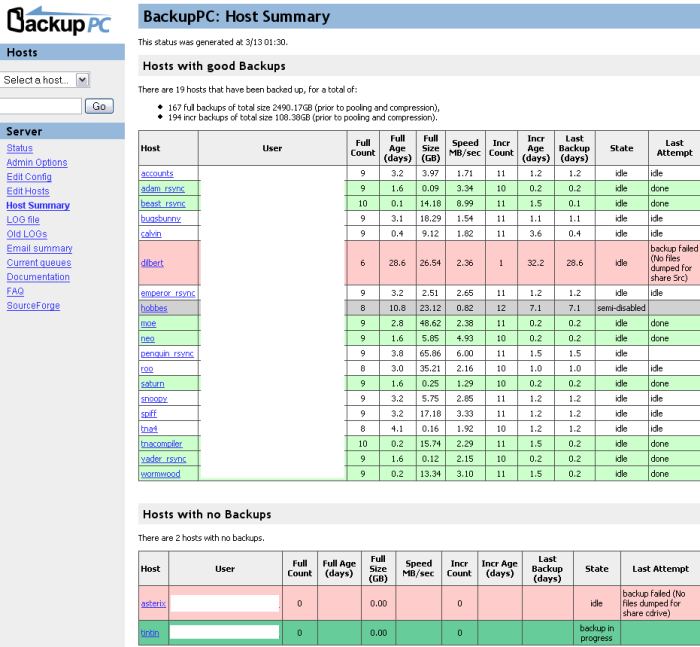BackupPC is a free backup software suite with a web-based frontend. It is a high-performance, enterprise-grade system for backing up Linux, Windows and Macs and laptops to a server’s disk.
Features include clever pooling of identical files, no client-side software, and a powerful Apache/CGI user interface. It is an entirely disk-based backup and recovery system. BackupPC incorporates a Server Message Block (SMB) client that can be used to back up network shares of computers running Windows. It also supports DHCP clients as long as the client is registered with a name service such as DNS, Active Directory, or LDAP.
BackupPC is highly configurable and easy to install and maintain.
The software can be configured to do a full backup at a regular interval. BackupPC can be configured to keep a certain number of full backups. Exponential expiry is also supported, allowing full backups with various vintages to be kept (for example, a settable number of most recent weekly fulls, plus a settable number of older fulls that are 2, 4, 8, or 16 weeks apart). BackupPC also supports multi-level incremental backups.
BackupPC is written in Perl and extracts backup data via SMB using Samba, tar over ssh/rsh/nfs, or rsync. It is robust, reliable, well documented and freely available as Open Source.
Features in more detail:
- Pooling scheme minimizes disk storage and disk I/O.
- Optional compression support further reducing disk storage. Since only new files (not already pooled) need to be compressed, there is only a modest impact on CPU time
- No client-side software is needed. tar over ssh/rsh/nfs is used to backup the data. With version 2.0.0, rsync is also supported on any client that has rsync or rysncd
- A powerful web (http/cgi) user interface allows administrators to view log files, configuration, current status and allows users to initiate and cancel backups and browse and restore files from backups.
- A full set of restore options is supported, including direct restore (via smbclient, tar, or rsync/rsyncd) or downloading a zip or tar file.
- Supports mobile environments where laptops are only intermittently connected to the network and have dynamic IP addresses (DHCP).
- Flexible configuration parameters allow multiple backups to be performed in parallel, specification of which shares to backup, which directories to backup or not backup, various schedules for full and incremental backups, schedules for email reminders to users and so on. Configuration parameters can be set system-wide or also on a per-PC basis.
- Users are sent periodic email reminders if their PC has not recently been backed up. Email content, timing and policies are configurable.
- Detailed documentation.
Website: backuppc.github.io/backuppc
Support: Documentation, GitHub Code Repository
Developer: Craig Barratt and contributors
License: GNU General Public License v3.0

BackupPC is written in Perl. Learn Perl with our recommended free books and free tutorials.
Return to Backup | Return to Deduplicating Encryption Backup Tools
| Popular series | |
|---|---|
| The largest compilation of the best free and open source software in the universe. Each article is supplied with a legendary ratings chart helping you to make informed decisions. | |
| Hundreds of in-depth reviews offering our unbiased and expert opinion on software. We offer helpful and impartial information. | |
| The Big List of Active Linux Distros is a large compilation of actively developed Linux distributions. | |
| Replace proprietary software with open source alternatives: Google, Microsoft, Apple, Adobe, IBM, Autodesk, Oracle, Atlassian, Corel, Cisco, Intuit, and SAS. | |
| Awesome Free Linux Games Tools showcases a series of tools that making gaming on Linux a more pleasurable experience. This is a new series. | |
| Machine Learning explores practical applications of machine learning and deep learning from a Linux perspective. We've written reviews of more than 40 self-hosted apps. All are free and open source. | |
| New to Linux? Read our Linux for Starters series. We start right at the basics and teach you everything you need to know to get started with Linux. | |
| Alternatives to popular CLI tools showcases essential tools that are modern replacements for core Linux utilities. | |
| Essential Linux system tools focuses on small, indispensable utilities, useful for system administrators as well as regular users. | |
| Linux utilities to maximise your productivity. Small, indispensable tools, useful for anyone running a Linux machine. | |
| Surveys popular streaming services from a Linux perspective: Amazon Music Unlimited, Myuzi, Spotify, Deezer, Tidal. | |
| Saving Money with Linux looks at how you can reduce your energy bills running Linux. | |
| Home computers became commonplace in the 1980s. Emulate home computers including the Commodore 64, Amiga, Atari ST, ZX81, Amstrad CPC, and ZX Spectrum. | |
| Now and Then examines how promising open source software fared over the years. It can be a bumpy ride. | |
| Linux at Home looks at a range of home activities where Linux can play its part, making the most of our time at home, keeping active and engaged. | |
| Linux Candy reveals the lighter side of Linux. Have some fun and escape from the daily drudgery. | |
| Getting Started with Docker helps you master Docker, a set of platform as a service products that delivers software in packages called containers. | |
| Best Free Android Apps. We showcase free Android apps that are definitely worth downloading. There's a strict eligibility criteria for inclusion in this series. | |
| These best free books accelerate your learning of every programming language. Learn a new language today! | |
| These free tutorials offer the perfect tonic to our free programming books series. | |
| Linux Around The World showcases usergroups that are relevant to Linux enthusiasts. Great ways to meet up with fellow enthusiasts. | |
| Stars and Stripes is an occasional series looking at the impact of Linux in the USA. | |
